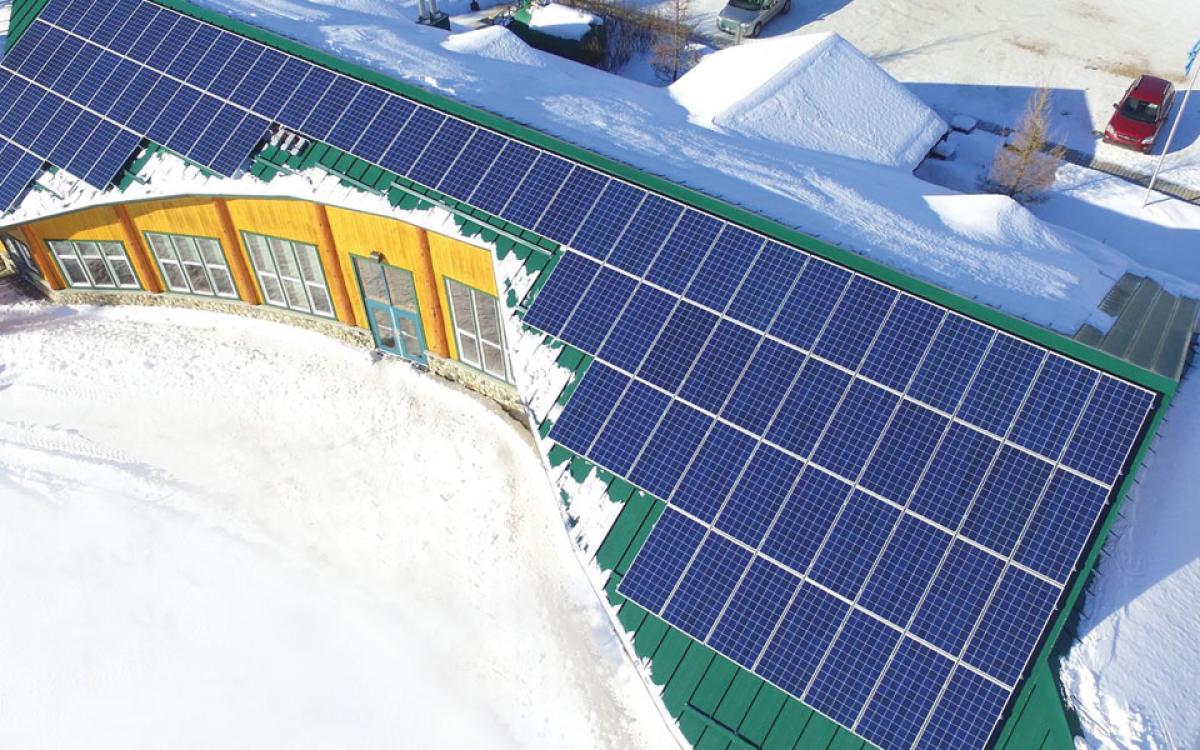On hot summer days when the sun beats down on Northern Canada from morning to midnight, solar photovoltaic systems are working continuously to turn solar energy into useable electricity. A 15-kilowatt system in Sachs Harbour, NWT is active 24 hours a day during summer months—gradually up to peak production from about mid-February, when the sun first returns.
At times, the system produces enough energy to run the hamlet office and still put power back into the grid. That’s the power of a sun that doesn’t set.
“We need to accept the fact that a higher latitude is a rotten place for sun in the winter,” says Klaus Dohring. “But in the summer, you get a nearly infinite amount.” His company Green Sun Rising has built and installed solar power systems across the country, from Sachs Harbour down to Canada’s southernmost point, Pelee Island, Ontario. (His goal is to get the indisputably northernmost system built in the world’s northernmost settlement, Alert, Nunavut. And he’s in talks to make that happen.)
But despite power literally overflowing throughout sunny summer days, there remains a lack of technology to store it for the sunless winters.
Batteries haven’t yet evolved to allow for the storage of large quantities of power over long periods of time. Newer energy storage systems, like Tesla’s Powerwall, address the day-to-day fluctuation of sunlight with batteries that store energy during peak hours for use after the sun sets. But, in terms of holding that charge for a few months, battery technology isn’t quite there yet. That means in the winter, power in many Northern communities still comes from non-renewable sources like diesel.
Chemical fuel cells could change that though. Alex Ip and a team of engineers and scientists at the University of Toronto are developing chemical fuel cells to store energy from renewable sources like the sun and wind. Unlike batteries that discharge over long periods of time, chemical fuel cells don’t lose their store of energy. “This is interesting when you’re on these seasonal timescales,” says Ip. “In the winter, when you’re not producing, you can take that [fuel] and produce electricity or burn it for heat, depending on what the fuel is.”
The system works by directing excess electricity from solar power systems through a catalyst to split either water (hydrogen and oxygen) or carbon dioxide (carbon and oxygen). In the first instance, oxygen is released while the remaining hydrogen is stored in the fuel cell. Energy is produced when oxygen is added back into the hydrogen fuel cell. Carbon, on the other hand, can be reformed into a usable carbon-based fuel like methane or ethanol, and used conventionally, like in a combustion engine.
There are systems in the works now for using hydrogen power, but catalyst materials remain expensive and inefficient—requiring a large amount of electricity to initiate the reaction and limiting how much energy can be produced. Ip’s team is trying to find the cheapest, most efficient catalyst.
Despite the obvious winter struggles, Shane Andre, director of the Yukon government’s energy branch, says from March to November, solar power systems generally perform well. Across the Yukon, there are 82 micro-generators and he says every community has at least one system in use—or in the works. Sow’s Ear Renewable Energy installed a system in Mount Lorne, Yukon that produces more than 8,000 kilowatt-hours per year for the small hamlet. In the NWT, solar projects are powering hamlet offices and private residences: a 100-killowatt system at the Fort Simpson airport can energize nearly 20 houses on a sunny day, while a bed and breakfast provides for itself in Sachs Harbour. An installation along an old runway strip in Colville Lake, NWT cut the community’s reliance on diesel fuel by 40 percent.
This winter, Klaus Dohring led a training project in Inuvik through the economic development arm of the Inuvialuit government, working with five local men to install a 5-kilowatt system on a community cooler. With more projects planned this summer, it helps to have a few trained workers on hand.










